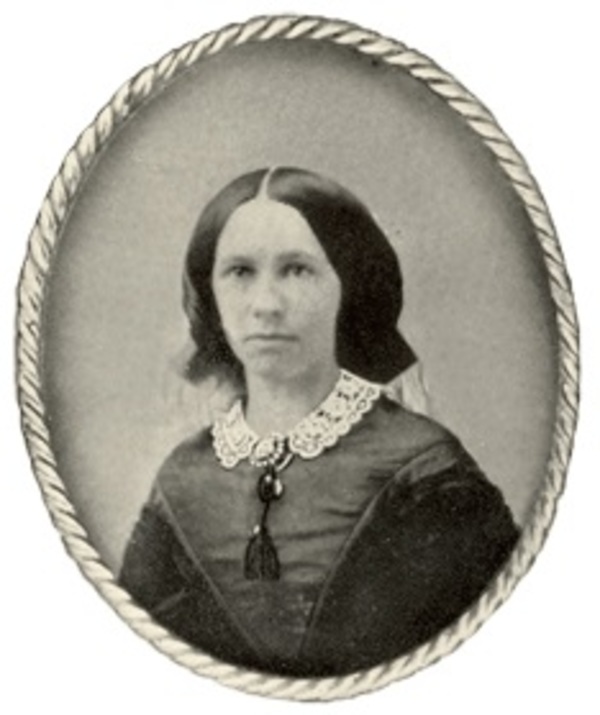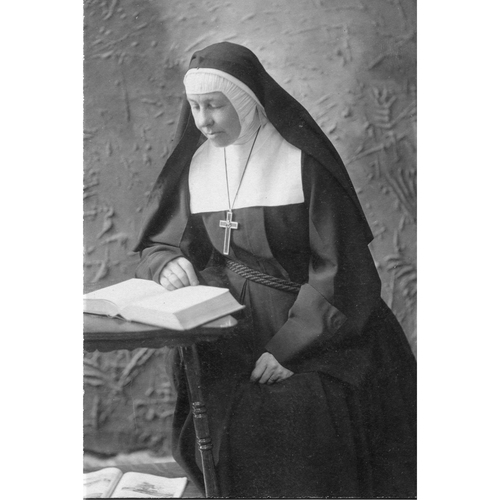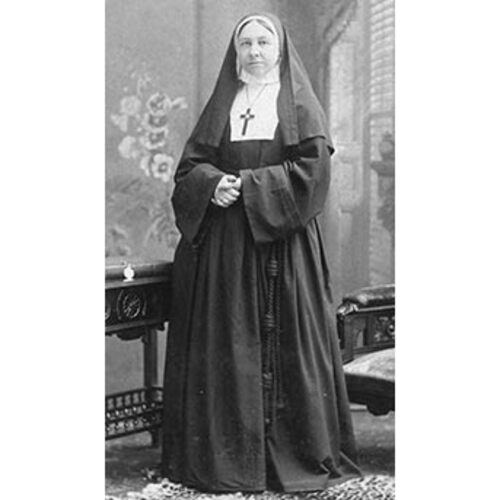
Source: Link
GRIER, SARAH HANNAH ROBERTA (Coome), founder and superior of the Sisters of St John the Divine; b. 28 Oct. 1837 in Carrying Place, Upper Canada, third daughter of John Grier and Eliza Lilias Geddes; m. 23 July 1859 Charles Horace Coome; d. 9 Feb. 1921 in Toronto.
Educated at home by her father, a high-church Anglican clergyman, Hannah Grier married a civil engineer working on the Grand Trunk Railway. For a time they resided in Kingston. In 1862 they moved to Britain, where Hannah was drawn to the mission work of the Anglican Sisters of St Mary. A fall during pregnancy resulted in the loss of her child and a long convalescence.
A year after their return to North America in 1877, Charles died in Chicago. Though Hannah contemplated going back to England “to offer her widowhood ... to God’s service,” she remained with a nephew and a brother in Chicago, taking a position at the School of Decorative Art and executing embroidery and hangings for churches. She was on her way to enter the Sisters of St Mary in 1881 when, stopping in Toronto to visit her mother, she was approached about forming a sisterhood there.
Under the leadership of Georgina Broughall, wife of the rector of St Stephen-in-the-Fields Church, and the Reverend Ogden Pulteney Ford, organizational meetings were held between November 1881 and April 1882. In June, Hannah Coome and Amelia Elizabeth (Aimée) Hare entered the noviciate of the Sisters of St Mary in Peekskill, N.Y. Anxious to gain experience in nursing and social work, Hannah spent some time at their hospital and missions in New York City. Meanwhile steps were being taken in Toronto to raise an endowment.
After making her profession on 8 Sept. 1884 in Peekskill, Hannah founded the Sisterhood of St John the Divine in Toronto, taking up residence there at Bishop Strachan School, where her sister Rose Jane Elizabeth* was principal. In December, Hannah and Aimée Hare occupied a converted house on Robinson Street, in a receptive parish known for its high-church traditions, and began work: meals for the poor, a dispensary, Bible classes, visitations, the provision of clothing, and sewing for churches. Reaction to a Protestant sisterhood was mixed. Despite the support of Bishop Arthur Sweatman* and even the Orange order, some Anglicans found the sisters’ black habits and religious practices too Catholic.
In the spring of 1885, during the North-West rebellion [see Darby Bergin*], Sweatman telegraphed Major-General John Wimburn Laurie to ask if volunteer nurses could serve. As a result of Laurie’s response, requesting trained nurses under one head, the diocese directed the Reverend John Langtry to approach the Sisterhood of St John. Leaving three sisters in Toronto, Hannah, a novice (Aimée Hare), and two postulants joined three lay nurses in staffing a field hospital in Moose Jaw (Sask.), where, aided by Dr William Canniff*, they tended the wounded from Batoche and Fish Creek. For her work, Hannah received a service medal from the government.
Following their return in July, the sisters quickly set up St John’s House on Euclid Avenue, the first surgical hospital for women in Toronto, and secured a staff of doctors. Over the next few years they progressed in several directions: a home for the aged (1886), an enlarged hospital and convent on Major Street (1888–89), incorporation of the order (with five sisters, 1889), a mission in Seaton Village north of Bloor Street (1890), and a system of lay associates and responsibility for Bishop Bethune College in Oshawa (1893). Though three British sisterhoods within the Church of England had established branches in Canada by 1900, the Sisters of St John remained the only Canadian order.
From the outset Hannah was insistent that they were never to beg for support, a condition that necessitated strong lay backing and periodic appeals. During her time as superior, the order was never large; the scope of their work often seemed to exceed their numbers. One result was the development of an extremely close religious community. Hannah was a pillar of strength who, though outwardly reserved, corresponded affectionately with sisters and novices when they were away. A shrewd financial administrator prone to overwork, she was compelled to take recuperative trips in 1889, 1894–95, and 1903. One of her last achievements was the opening in 1915 of a mission in the new east-end parish of All Hallows, where people were so well off, the sister-in-charge reported, “that we have to work persistently and patiently to get them to attend Church.”
In June 1916 Hannah, at age 78, resigned as superior and was succeeded by her niece Dora Lilias Grier. She died in 1921 and was buried in St James’ Cemetery. Today the sisterhood is best known for its rehabilitation hospital and retreat centres.
Toronto Daily Star, 10 Feb. 1921. P. F. Anson, The call of the cloister: religious communities and kindred bodies in the Anglican communion (London, 1958). A memoir of the life and work of Hannah Grier Coome, mother-foundress of the Sisterhood of St. John the Divine, Toronto, Canada (London, 1933). Religious communities in the American Episcopal Church and in the Anglican Church of Canada (rev. ed., New York, 1956; copy in the contributor’s possession). The Sisterhood of Saint John the Divine, 1884–1984 (4th revision, Willowdale [Toronto], 1984).
Cite This Article
Murray W. Nicolson, “GRIER, SARAH HANNAH ROBERTA (Coome),” in Dictionary of Canadian Biography, vol. 15, University of Toronto/Université Laval, 2003–, accessed January 22, 2025, https://www.biographi.ca/en/bio/grier_sarah_hannah_roberta_15E.html.
The citation above shows the format for footnotes and endnotes according to the Chicago manual of style (16th edition). Information to be used in other citation formats:
| Permalink: | https://www.biographi.ca/en/bio/grier_sarah_hannah_roberta_15E.html |
| Author of Article: | Murray W. Nicolson |
| Title of Article: | GRIER, SARAH HANNAH ROBERTA (Coome) |
| Publication Name: | Dictionary of Canadian Biography, vol. 15 |
| Publisher: | University of Toronto/Université Laval |
| Year of revision: | 2005 |
| Access Date: | January 22, 2025 |





